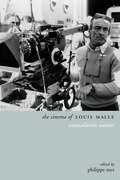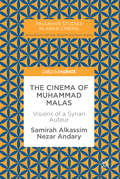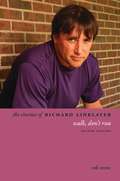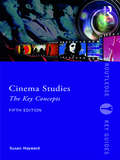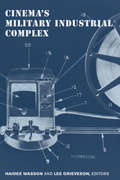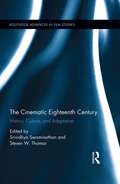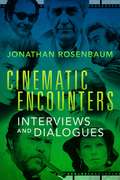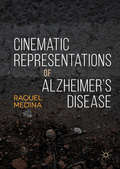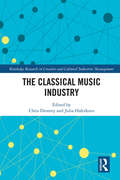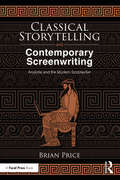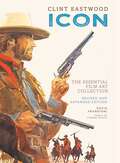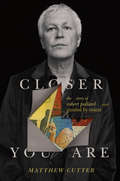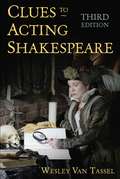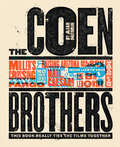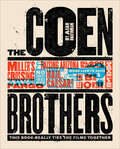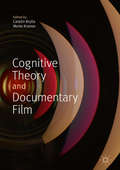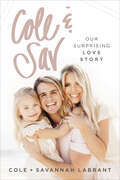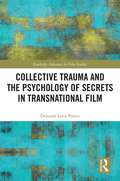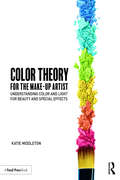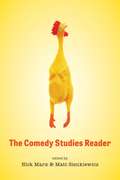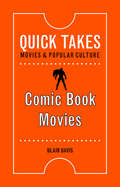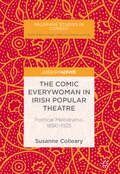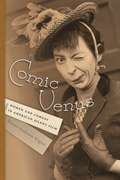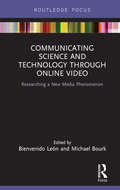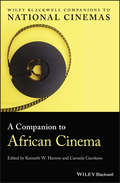- Table View
- List View
The Cinema of Louis Malle: Transatlantic Auteur (Directors' Cuts)
by Philippe MetArguably a pioneer of the French New Wave (with Ascenseur pour l’échafaud, 1957) Louis Malle went on to enjoy an acclaimed yet provocative and versatile transatlantic career. This collection of original essays proposes to reassess his richly eclectic and boldly subversive oeuvre and redress the surprising critical neglect it has suffered over the years. It does so through a combination of transversal and monographic analyses that use a variety of critical lenses and theoretical tools in order to examine Malle’s documentaries as well as his fiction features (and, more importantly, the constant shuttling and uniquely persistent cross-pollination between those two cinematic approaches), illuminate the profound, lasting dialogue his films entertained with literature and theater, bring to the fore their sustained, albeit often oblique autobiographical thrust along with their scathing sociopolitical critique, and scrutinize the alternating use of stars and non-professional actors.In addition, the volume features an exclusive interview with the acclaimed playwright John Guare (a close friend and collaborator of Louis Malle’s who scripted Atlantic City) and is bookended by a foreword by Volker Schlöndorff and an afterword by Wes Anderson, two renowned filmmakers who articulate their admiration for, and the seminal influence of, their predecessor.
The Cinema of Muhammad Malas: Visions of a Syrian Auteur (Palgrave Studies in Arab Cinema)
by Samirah Alkassim Nezar AndaryThis book provides an in-depth and intimate study of the cinema of Muhammad Malas. One of the well-known auteurs of Arab and Syrian cinema, Malas’s distinctive cinematic project has always confronted the social and political issues of his time. From feature films Dreams of the City, The Night, Bab al Maqam (Passion), and Ladder to Damascus to documentaries such as The Dream and Aleppo: Maqamat of Pleasure, Malas’s films challenge and explore Arab culture and history. Archival images run through the chapters of this book which combines insightful interviews with excerpts from Malas’s literary works and critical explorations of his cinematic style and thematic concerns. The book concludes with Malas’s own words, sharing the treatment of his film project Cinema al-Dunya.
The Cinema of Richard Linklater: Walk, Don't Run (Directors' Cuts)
by Rob StoneFrom Slacker (1991), a foundational work of independent American cinema, to the Before trilogy, Richard Linklater’s critically acclaimed films and aesthetic ambition have earned him a place as one of the most important contemporary directors. In this second edition of The Cinema of Richard Linklater, Rob Stone shows how Linklater’s latest films have redefined our understanding of his work. He offers critical discussions and analysis of all of Linklater’s films, including Before Midnight (2013) and Everybody Wants Some!! (2016), as well as new interviews with Linklater and a chapter on Boyhood (2014), hailed as one of the best films of the twenty-first century.Stone explores the theoretical, practical, contextual, and metaphysical elements in Linklater’s filmography, especially his experimentation with cinematic representations of time and growth. He demonstrates that fanciful lives and lucid dreams are as central as alternative notions of America and time to Linklater’s films. Stone also considers Linklater’s collaborative working practices, his deployment of such techniques as rotoscoping, and his innovative distribution strategies. Thoroughly revised, updated, and extended, the book includes analysis of all of Linklater’s films, including Dazed and Confused (1993), Waking Life (2011), and A Scanner Darkly (2006) as well as his documentaries, short films, and side projects.
Cinema Studies: The Key Concepts (Routledge Key Guides)
by Susan HaywardCinema Studies: The Key Concepts is essential reading for anyone interested in film. Providing accessible coverage of a comprehensive range of genres, movements, theories and production terms, this is a must-have guide to a fascinating area of study and arguably the greatest art form of modern times. Now fully revised and updated for its fifth edition, the book includes entries on topics such as: Acting Audience CGI Convergence Cult cinema Digitisation and globalization Distribution Experimental film Transnational cinema World cinemas
Cinema's Military Industrial Complex
by Haidee Wasson Lee GrievesonThe vast and influential American military has been aided and abetted by cinema since the earliest days of the medium. The army, navy, and air force put films to work in myriad ways, enlisting them to entertain, train, and heal soldiers as well as to propagandize, strategize, spy, map, and develop weapons, from rifles to atomic bombs. Presenting new essays based on archival research, Cinema’s Military Industrial Complex addresses the relationship of military cinema to Hollywood, technological innovation, new modes of filmmaking, unique film styles and genres, and the rise of American soft power across the long twentieth century. This rich and timely volume is essential for scholars interested in the military’s use of media and the exercise of influence within and beyond American borders.
The Cinematic Eighteenth Century: History, Culture, and Adaptation (Routledge Advances in Film Studies)
by Srividhya Swaminathan Steven W. ThomasThis collection explores how film and television depict the complex and diverse milieu of the eighteenth century as a literary, historical, and cultural space. Topics range from adaptations of Austen’s Sense and Sensibility and Defoe's Robinson Crusoe (The Martian) to historical fiction on the subjects of slavery (Belle), piracy (Crossbones and Black Sails), monarchy (The Madness of King George and The Libertine), print culture (Blackadder and National Treasure), and the role of women (Marie Antoinette, The Duchess, and Outlander). This interdisciplinary collection draws from film theory and literary theory to discuss how film and television allows for critical re-visioning as well as revising of the cultural concepts in literary and extra-literary writing about the historical period.
Cinematic Encounters: Interviews and Dialogues
by Jonathan RosenbaumGodard. Fuller. Rivette. Endfield. Tarr. In his celebrated career as a film critic, Jonathan Rosenbaum has undertaken wide-ranging dialogues with many of the most daring and important auteurs of our time. Cinematic Encounters collects more than forty years of interviews that embrace Rosenbaum's vision of film criticism as a collaboration involving multiple voices. Rosenbaum accompanies Orson Welles on a journey back to Heart of Darkness , the unmade film meant to be Welles's Hollywood debut. Jacques Tati addresses the primacy of décor and soundtrack in his comedic masterpiece PlayTime, while Jim Jarmusch explains the influence of real and Hollywoodized Native Americans in Dead Man. By arranging the chapters chronologically, Rosenbaum invites readers to pursue thematic threads as if the discussions were dialogues between separate interviews. The result is a rare gathering of filmmakers trading thoughts on art and process, on great works and false starts, and on actors and intimate moments.
Cinematic Representations of Alzheimer’s Disease
by Raquel MedinaThis book offers a cross-cultural approach to cinematic representations of Alzheimer’s disease in non-mainstream cinema. Even though Alzheimer’s disease, the most common form of dementia, is a global health issue, it is not perceived or represented homogenously around the world. Contrary to very well-known mainstream films, the films discussed do not focus on the negative aspects normally associated with Alzheimer’s disease, but on the importance of portraying the perspective of the persons living with Alzheimer’s and their personhood. Similarly, this book analyses how the films use Alzheimer’s as a trope to address issues relating to different areas of life and society such as, for example, family matters, intergenerational relationships, gender issues, national traditions versus global modernity, and caring for people with dementia. By examining an array of films, from crime fiction to documentary, that each present non-stigmatising representations of Alzheimer’s disease, this in-depth study ultimately demonstrates the power of culture in shaping meaning.
The Classical Music Industry (Routledge Research in Creative and Cultural Industries Management)
by Chris Dromey Julia HaferkornThis volume brings together academics, executives and practitioners to provide readers with an extensive and authoritative overview of the classical music industry. The central practices, theories and debates that empower and regulate the industry are explored through the lens of classical music-making, business, and associated spheres such as politics, education, media and copyright. The Classical Music Industry maps the industry’s key networks, principles and practices across such sectors as recording, live, management and marketing: essentially, how the cultural and economic practice of classical music is kept mobile and alive. The book examining pathways to professionalism, traditional and new forms of engagement, and the consequences of related issues—ethics, prestige, gender and class—for anyone aspiring to ‘make it’ in the industry today. This book examines a diverse and fast-changing sector that animates deep feelings. The Classical Music Industry acknowledges debates that have long encircled the sector but today have a fresh face, as the industry adjusts to the new economics of funding, policy-making and retail The first volume of its kind, The Classical Music Industry is a significant point of reference and piece of critical scholarship, written for the benefit of practitioners, music-lovers, students and scholars alike offering a balanced and rigorous account of the manifold ways in which the industry operates.
Classical Storytelling and Contemporary Screenwriting: Aristotle and the Modern Scriptwriter
by Brian PriceSince we first arrived on the planet, we’ve been telling each other stories, whether of that morning’s great saber-tooth tiger hunt or the latest installment of the Star Wars saga. And throughout our history, despite differences of geography or culture, we’ve been telling those stories in essentially the same way. Why? Because there is a RIGHT way to tell a story, one built into our very DNA. In his seminal work Poetics, Aristotle identified the patterns and recurring elements that existed in the successful dramas of his time as he explored precisely why we tell stories, what makes a good one, and how to best tell them. In Classical Storytelling and Contemporary Screenwriting, Brian Price examines Aristotle’s conclusions in an entertaining and accessible way and then applies those guiding principles to the most modern of storytelling mediums, going from idea to story to structure to outline to final pages and beyond, covering every relevant screenwriting topic along the way. The result is a fresh new approach to the craft of screenwriting—one that’s only been around a scant 2,500 years or so—ideal for students and aspiring screenwriters who want a comprehensive step-by-step guide to writing a successful screenplay the way the pros do it.
Clint Eastwood: The Essential Film Art Collection
by Insight EditionsFeaturing rare, outstanding additional content, Clint Eastwood: Icon is the definitive collection of film art and material representing Clint Eastwood&’s legendary career as seen through the original iconic artwork.Clint Eastwood is a nameless vigilante, a vengeful detective, a bare-knuckle boxer, a Secret Service agent, and countless other definitive screen archetypes now embedded in our shared pop-culture consciousness. However you define him, Clint Eastwood has a powerful and extremely recognizable image that exists as something beyond the narratives of his films. Featuring a wealth of additional content, this new edition of Clint Eastwood: Icon presents an unprecedented collection of film art and rare material surrounding the legendary actor. This comprehensive trove gathers together poster art, lobby cards, standees, Italian Spaghetti Western Premier posters, studio ads, and esoteric film memorabilia from around the world. From his early roles as the nameless gunslinger in Sergio Leone&’s spaghetti Westerns, to the vigilante films of the 1970s and 1980s, through his directorial roles and latest releases, Clint Eastwood: Icon captures the powerful presence that turned Eastwood into the definitive American hero.
Closer You Are: The Story of Robert Pollard and Guided By Voices
by Matthew CutterThe authorized biography of Robert Pollard, indie rock icon and founder of the music group Guided By VoicesRobert Pollard has been a staple of the indie rock scene since the early '80s, along with his band Guided By Voices. Pollard was a longtime grade school teacher who toiled endlessly on his music, finding success only after adopting a do-it-yourself approach, relying on lo-fi home recordings for much of his and his band's career. A prolific artist, Pollard continues to churn out album after album, much to the acclaim of critics and his obsessive and devoted fans. But his story has never been faithfully told in its entirety. Until now.Author Matthew Cutter is a longtime friend of Pollard and, with Pollard's blessing, he's set out to tell the whole, true story of Guided By Voices. Closer You Are is the first book to take an in-depth look at the man behind it all, with interviews conducted by the author with Pollard's friends, family, and bandmates, along with unfettered access to Pollard himself and his extensive archives.Robert Pollard has had an amazing and seemingly endless career in rock music, but he's also established himself as a consummate artist who works on his own terms. Now fans can at long last learn the full story behind one of America's greatest living songwriters.
Clues to Acting Shakespeare
by Wesley Van TasselClues to Acting Shakespeare has become a popular guide for actors, directors, teachers and Shakespeare enthusiasts, selling over 15,000 copies of previous editions. This third edition retains the second edition’s unique solutions to challenges that face directors and actors at advanced levels and is expanded to include an entirely new section for amateur and community theatre groups. In this new edition, readers will be delighted to find: New section to aid community theatres to perform Shakespeare’s plays, including five recorded workshops of community theatre actors coached and trained by the author Updates to the successful sections on training student actors (MFA and BFA programs), and professional actors (including audition tips)—highlighted by twenty author-coached workshops with professional and advanced student actors Improved section for teachers of high school and child actors with worksheets and sample lesson plans New exercises and resources for all levels of acting and production To aid professionals, Clues to Acting Shakespeare offers a one-day brush-up for auditions and preparation to play Shakespeare immediately. Text analysis, character studies, and both classical British training and American methods are explored. The exercises and recorded workshops provide inspiring advice to all actors and demonstrate concepts discussed throughout the book. The critical skills required for acting Shakespeare, including scansion, phrasing, caesura, breathing, speech structure, antithesis, and more are covered in detail. The comprehensive exercises using the Bard’s plays and sonnets teach actors to break down the verse, support the words, understand the imagery, and use the text to create vibrant performances.
The Coen Brothers: This Book Really Ties the Films Together
by Adam Nayman“Color stills, behind-the-scenes stories, interviews and insightful analysis of each film…will put a smile on the face of all film buffs.” ?The Detroit Free PressFrom such cult hits as Raising Arizona (1987) and The Big Lebowski (1998) to major critical darlings Fargo (1996), No Country for Old Men (2007), and Inside Llewyn Davis (2013), Ethan and Joel Coen have cultivated a bleakly comical, instantly recognizable voice in modern American cinema. In The Coen Brothers: This Book Really Ties the Films Together, film critic Adam Nayman carefully sifts through their complex cinematic universe in an effort to plot, as he puts it, “some Grand Unified Theory of Coen-ness.” The book combines critical text—biography, close film analysis, and enlightening interviews with key Coen collaborators—with a visual aesthetic that honors the Coens’ singular mix of darkness and levity. Featuring film stills, beautiful and evocative illustrations, punchy infographics, and hard insight, this book is the definitive exploration of the Coen brothers’ oeuvre.
The Coen Brothers (Text-only Edition): This Book Really Ties the Films Together
by Adam NaymanFans of Fargo, The Big Lebowski, No Country for Old Men, and other modern classics will enjoy this “definitive history of the Coen brothers oeuvre” (Indiewire).From such cult hits as Raising Arizona (1987) and The Big Lebowski (1998) to major critical darlings Fargo (1996), No Country for Old Men (2007), and Inside Llewyn Davis (2013), Ethan and Joel Coen have cultivated a bleakly comical, instantly recognizable voice in modern American cinema. In The Coen Brothers: This Book Really Ties the Films Together, film critic Adam Nayman carefully sifts through their complex cinematic universe in an effort to plot, as he puts it, “some Grand Unified Theory of Coen-ness.” With a combination of biography, close analysis, and enlightening interviews with key Coen collaborators, this book honors the films’ singular mix of darkness and levity, and is the definitive exploration of the Coen brothers’ oeuvre.
Cognitive Theory and Documentary Film
by Catalin Brylla Mette KramerThis groundbreaking edited collection is the first major study to explore the intersection between cognitive theory and documentary film studies, focusing on a variety of formats, such as first-person, wildlife, animated and slow TV documentary, as well as docudrama and web videos. Documentaries play an increasingly significant role in informing our cognitive and emotional understanding of today’s mass-mediated society, and this collection seeks to illuminate their production, exhibition, and reception. Taking an interdisciplinary approach, the essays draw on the latest research in film studies, the neurosciences, cultural studies, cognitive psychology, social psychology, and the philosophy of mind. With a foreword by documentary studies pioneer Bill Nichols and contributions from both theorists and practitioners, this volume firmly demonstrates that cognitive theory represents a valuable tool not only for film scholars but also for filmmakers and practice-led researchers.
Cole & Sav: Our Surprising Love Story
by Cole LaBrant Savannah LaBrantPopular YouTubers the Labrant Fam share their inspiring love story of how Savannah, a young, single mom, fell in love with Cole, a 19-year-old from Alabama, highlighting the redemptive, surprising nature of God at work in our lives.The Labrant Fam—Cole, Savannah, and their daughter, Everleigh—have laughed, pranked, and danced their way into the hearts of millions of viewers. But by all accounts, Cole and Savannah shouldn&’t have met each other—let alone fallen in love.Sav was a 23-year-old from Southern California who had grown up with the pain of her parents&’ broken marriage. As a single mother with a history of unhealthy relationships, she had all but given up on a happily ever after.Cole was a 19-year-old from a small town in Alabama who had never dated seriously but held high hopes for marriage. Cole was slowly learning how to trust life's twists and turns. Then, through a surprise encounter, their lives changed forever.In this heartwarming memoir, you&’ll discover:The heartbreak Savannah faced as a young, single mom before she met ColeTheir individual stories growing upSavannah&’s pregnancy at 19 and how she found fame on social mediaHow they met and fell in loveWith their signature charming and engaging style, Cole and Sav take you behind the camera and open up about past heartaches and mistakes; painful secrets and difficult expectations; the joys and challenges of raising their daughter, Everleigh; and the spiritual journey that changed their hearts—and relationship—forever.
Collective Trauma and the Psychology of Secrets in Transnational Film (Routledge Advances in Film Studies)
by Deborah Lynn PorterCollective Trauma and the Psychology of Secrets in Transnational Film advances a methodological line of inquiry based on a fresh insight into the ways in which cinematic meaning is generated and can be ascertained. Premised on a critical reading strategy informed by a metapsychology of secrets, the book features analyses of internationally acclaimed films—Guillermo del Torro’s Pan’s Labyrinth, Andrey Zvyagintsev’s The Return, Jee-woon Kim’s A Tale of Two Sisters, and Alejandro Amenábar’s The Others. It demonstrates how a rethinking of the figure of the secret in national film yields a new vantage point for examining heretofore unrecognized connections between collective historical experience, cinematic production and a transnational aesthetic of concealment and hiding.
Color Theory for the Makeup Artist: Understanding Color and Light for Beauty and Special Effects
by Katie MiddletonColor Theory for the Make-up Artist: Understanding Color and Light for Beauty and Special Effects analyzes and explains traditional color theory for fine artists and applies it to the make-up artist. This book is suitable for both professionals and beginners who wish to train their eye further to understand and recognize distinctions in color. It explains why we see color, how to categorize and identify color, relationships between colors, and it relates these concepts to beauty and special effects make-up. The book teaches the reader how to mix flesh tones by using only primary colors, and explains how these colors in paints and make-up are sourced and created. It also discusses the reason for variations in skin colors and undertones, and how to identify and match these using make-up, while choosing flattering colors for the eyes, lips, and cheeks. Colors found inside the body are explained for special effects make-up, like why we bruise, bleed, or appear sick. Ideas and techniques are also described for painting prosthetics, in addition to using color as inspiration in make-up designs. The book also discusses how lighting affects color on film, television, theater, and photography sets, and how to properly light a workspace for successful applications.
The Comedy Studies Reader
by Nick Marx Matt SienkiewiczFrom classical Hollywood film comedies to sitcoms, recent political satire, and the developing world of online comedy culture, comedy has been a mainstay of the American media landscape for decades. Recognizing that scholars and students need an authoritative collection of comedy studies that gathers both foundational and cutting-edge work, Nick Marx and Matt Sienkiewicz have assembled The Comedy Studies Reader. This anthology brings together classic articles, more recent works, and original essays that consider a variety of themes and approaches for studying comedic media—the carnivalesque, comedy mechanics and absurdity, psychoanalysis, irony, genre, race and ethnicity, gender and sexuality, and nation and globalization. The authors range from iconic theorists, such as Mikhail Bakhtin, Sigmund Freud, and Linda Hutcheon, to the leading senior and emerging scholars of today. As a whole, the volume traces two parallel trends in the evolution of the field—first, comedy’s development into myriad subgenres, formats, and discourses, a tendency that has led many popular commentators to characterize the present as a “comedy zeitgeist”; and second, comedy studies’ new focus on the ways in which comedy increasingly circulates in “serious” discursive realms, including politics, economics, race, gender, and cultural power.
Comic Book Movies (Quick Takes: Movies and Popular Culture)
by Blair DavisComic Book Movies explores how this genre serves as a source for modern-day myths, sometimes even incorporating ancient mythic figures like Thor and Wonder Woman’s Amazons, while engaging with the questions that haunt a post-9/11 world: How do we define heroism and morality today? How far are we willing to go when fighting terror? How can we resist a dystopian state? Film scholar Blair Davis also considers how the genre’s visual style is equally important as its weighty themes, and he details how advances in digital effects have allowed filmmakers to incorporate elements of comic book art in innovative ways. As he reveals, comic book movies have inspired just as many innovations to Hollywood’s business model, with film franchises and transmedia storytelling helping to ensure that the genre will continue its reign over popular culture for years to come.
The Comic Everywoman in Irish Popular Theatre: Political Melodrama, 1890-1925 (Palgrave Studies in Comedy)
by Susanne CollearyThis book is a comprehensive study of comic women in performance as Irish Political Melodrama from 1890 to 1925. It maps out the performance contexts of the period, such as Irish “poor” theatre both reflecting and complicating narratives of Irish Identity under British Rule. The study investigates the melodramatic aesthetic within these contexts and goes on to analyse a selection of the melodramas by the playwrights J.W. Whitbread and P.J. Bourke. In doing so, the analyses makes plain the comic structures and intent that work across both character and action, foregrounding comic women at the centre of the discussion. Finally, the book applies a “practice as research” dimension to the study. Working through a series of workshops, rehearsals and a final performance, Colleary investigates comic identity and female performance through a feminist revisionist lens. She ultimately argues that the formulation of the Comic Everywoman as staged “Comic” identity can connect beyond the theatre to her “Everyday” self. This book is intended for those interested in theatre histories, comic women and in popular performance.
Comic Venus: Women And Comedy In American Silent Film (Contemporary Approaches To Film And Media Ser.)
by Kristen Anderson WagnerFor many people the term “silent comedy” conjures up images of Charlie Chaplin’s Little Tramp, Buster Keaton’s Stoneface, or Harold Lloyd hanging precariously from the side of a skyscraper. Even people who have never seen a silent film can recognize these comedians at a glance. But what about the female comedians? Gale Henry, Louise Fazenda, Colleen Moore, Constance Talmadge—these and numerous others were wildly popular during the silent film era, appearing in countless motion pictures and earning top salaries, and yet, their names have been almost entirely forgotten. As a consequence, recovering their history is all the more compelling given that they laid the foundation for generations of funny women, from Lucille Ball to Carol Burnett to Tina Fey. These women constitute an essential and neglected sector of film history, reflecting a turning point in women’s social and political history. Their talent and brave spirit continues to be felt today, and Comic Venus: Women and Comedy in American Silent Film seeks to provide a better understanding of women’s experiences in the early twentieth century, and to better understand and appreciate the unruly and boundary-breaking women who have followed. The diversity and breadth of archival materials explored in Comic Venus illuminate the social and historical period of comediennes and silent film. In four sections, Kristen Anderson Wagner enumerates the relationship between women and comedy, beginning with the question of why historically women weren’t seen as funny or couldn’t possibly be funny in the public and male eye, a question that persists even today. Wagner delves into the idea of women’s “delicate sensibilities,” which presumably prevented them from being funny, and in chapter two traces ideas about feminine beauty and what a woman should express versus what these comedic women did express, as Wagner notes, “comediennes challenged the assumption that beauty was a fundamental component of ideal femininity.” In chapter three, Wagner discusses how comediennes such as Clara Bow, Marie Dressler, and Colleen Moore used humor to gain recognition and power through performances of sexuality and desire. Women comedians presented “sexuality as fun and playful, suggesting that personal relationships could be fluid rather than stable.” Chapter four examines silent comediennes’ relationships to the modern world and argues that these women exemplified modernity and new womanhood. The final chapter of Comic Venus brings readers to understand comediennes and their impact on silent-era cinema, as well as their lasting influence on later generations of funny women. Comic Venus is the first book to explore the overlooked contributions made by comediennes in American silent film. Those with a taste for film and representations of femininity in comedy will be fascinated by the analytical connections and thoroughly researched histories of these women and their groundbreaking movements in comedy and stage.
Communicating Science and Technology Through Online Video: Researching a New Media Phenomenon (Routledge Focus on Communication Studies)
by Bienvenido León Michael BourkOnline video’s unique capacity to reach large audiences makes it a powerful tool to communicate science and technology to the general public. The outcome of the international research project "Videonline," this book provides a unique insight into the key elements of online science videos, such as narrative trends, production characteristics, and issues of scientific rigor. If offers various methodological approaches: a literature review, content analysis, and interviews and surveys of expert practitioners to provide information on how to maintain standards of rigour and technical quality in video production.
A Companion to African Cinema (Wiley Blackwell Companions to National Cinemas)
by Kenneth W. HarrowAn authoritative guide to African cinema with contributions from a team of experts on the topic A Companion to African Cinema offers an overview of critical approaches to African cinema. With contributions from an international panel of experts, the Companion approaches the topic through the lens of cultural studies, contemporary transformations in the world order, the rise of globalization, film production, distribution, and exhibition. This volume represents a new approach to African cinema criticism that once stressed the sociological and sociopolitical aspects of a film. The text explores a wide range of broad topics including: cinematic economics, video movies, life in cinematic urban Africa, reframing human rights, as well as more targeted topics such as the linguistic domestication of Indian films in the Hausa language and the importance of female African filmmakers and their successes in overcoming limitations caused by gender inequality. The book also highlights a comparative perspective of African videoscapes of Southern Nigeria, Ethiopia, and Côte d’Ivoire and explores the rise of Nairobi-based Female Filmmakers. This important resource: Puts the focus on critical analyses that take into account manifestations of the political changes brought by neocolonialism and the waning of the cold war Explores Examines the urgent questions raised by commercial video about globalization Addresses issues such as funding, the acquisition of adequate production technologies and apparatuses, and the development of adequately trained actors Written for film students and scholars, A Companion to African Cinema offers a look at new critical approaches to African cinema.
